Sales is the engine of every company – and yet, unfortunately, sales optimisation is all too often neglected. But like a regular oil change in a car, a regular review of sales measures is enormously important to ensure the success of a company. In our digital and particularly fast-moving times, sales is also subject to constant change and development processes. Potential for sales optimisation can therefore arise again and again. But they must also be discovered in order to ensure efficient, customer-friendly and modern sales. Services, sales team, sales strategy and the individual sales channels must be subjected to regular examination in order to ensure the achievement of sales goals. The goal should be to ensure operational success and increased sales in the long term through continuous sales optimisation.
An intelligent, intuitive sales app can significantly increase efficiency in everyday sales. Learn more about this in our free infographic:
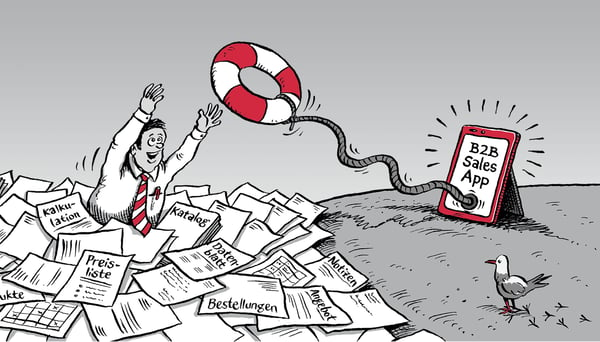
Developing an efficient way of working and generating new customers are essential tasks of the sales team. These should be based on a comprehensive and detailed sales concept that can be flexibly adapted according to needs and technological or entrepreneurial developments.
In short, "flexibility" and "efficiency" are important key words to consider in sales optimisation if you want your sales team to be continuously successful.
Table of contents
- What is sales optimisation?
- How to measure sales efficiency?
- 1. Digital integration in the sales process
- 2. Individualised customer approach
- 3. Ongoing education and training
- 4. Post-sale engagement
- 5. Feedback loops and continuous improvement
- 6. Predictive analytics and sales forecasting
- 7. Cross-selling and up-selling with data analysis
- Conclusion
WHAT IS SALES OPTIMISATION?
The term "sales optimisation" refers to the targeted improvement of sales processes and strategies. The goal is to increase the efficiency and profitability of a company in the sales area. In this context, it is of course also important to increase turnover, strengthen customer loyalty and reduce sales costs. These points can be implemented in various ways.
The first point of reference is usually process optimisation. Through analyses and improvements of the sales processes, weak points such as bottlenecks can be discovered and eliminated. In addition, comprehensive analyses can reveal optimisation potential for workflows in order to make them more efficient. For example, the introduction of automated tools to reduce manual tasks can represent a significant optimisation.
Furthermore, sales strategies should be continuously reviewed and, if necessary, adapted to better meet the needs and expectations of (potential) customers. For example, a marketing-segmentation of the market, a change in pricing or an adjusted positioning of the company could be an optimisation of the sales strategy.
In addition, the sales staff, data analyses, smart technologies and tools as well as adequate performance measurement and evaluation can hold optimisation potential for companies in the sales area.
These points must be subject to regular review and re-evaluation, as markets, customer needs and competition are constantly changing. An investment in sales optimisation often pays off quickly for companies. They can increase competitiveness and achieve more sustainable business results. Which industry a company belongs to or how big it is plays a secondary role, as the following applies first and foremost: There is always something to optimise!
HOW DO YOU MEASURE SALES EFFICIENCY?
Sales efficiency refers to how well a company is able to optimise its sales activities in such a way that sales targets are achieved with the least possible expenditure of resources.
Sales efficiency is measured by collecting and evaluating certain key performance indicators (KPIs). Both quantitative and qualitative metrics can play a role. Exactly which KPIs are meaningful with regard to sales efficiency depends on the goals and certain characteristics of the company (e.g. is it B2B or B2C, which industry does the company belong to, etc.).
In the following, we briefly discuss key figures that can be of importance for a company when it comes to statements on sales efficiency:
- Sales growth over time is one of the most basic metrics. Here, the turnover in total, per sales channel or per sales employee can be relevant.
- The conversion rate indicates the percentage of potential customers who have taken a certain action. The conversion goal can be, for example, filling out a form on the website or a purchase in the online shop. Sales figures are often the most relevant for sales. Conversion rate can be measured for different stages of the sales funnel, from lead generation to contract closure.
- Sales costs are another important indicator of sales efficiency. The sales costs per acquired customer are recorded. The lower these costs are, the more efficient the sales department is.
- The sales volume per sales employee (on average).
- The sales cycle time indicates how much time is needed to close a sale from the first contact to the closing. A shortened sales cycle duration is usually positive.
- Measuring customer satisfaction and retention can indirectly indicate sales effectiveness. Satisfied customers are more likely to buy again and make recommendations.
- Furthermore, classic sales indicators such as the number of acquisition contacts, the number of closings or the number of offers that were converted into orders are important indicators that can be used to measure the effectiveness of sales processes.
- The profitability of sales can be evaluated by looking at gross and net profit margins at the sales level.
Comprehensive monitoring of sales activities, processes and results is essential to identify potential for optimisation. It helps to better understand the performance of your sales team and lets you know which sales types and people are successful.
1. DIGITAL INTEGRATION IN THE SALES PROCESS
Digitalisation is spreading to almost every area of the company - and there is a reason for that! It enables an attractive increase in efficiency in many areas and thus the conservation of valuable resources that may contribute to success elsewhere in the company. Many companies have already recognised this, but often there is no complete digital integration. Customer information or documentation may still be issued and processed in paper form. Valuable data that could have revealed optimisation potential can be lost in the process. A complete digitalisation of sales processes provides transparency and a complete data situation that your employees need to work efficiently and discover opportunities for improvement.
In addition, digitalisation also enables the automation of marketing activities and sales processes, which can relieve your employees enormously, increase efficiency and improve customer satisfaction. All of this ultimately leads to an increase in turnover and maximisation of the company's success.
The advantages at a glance
- Time savings: Automation allows staff to focus on strategic tasks, increasing productivity and strengthening customer relationships.
- Digitalisation & automation support consistent processes, tasks and customer communication.
- Effective lead management: Automation of lead generation and qualification enables employees to focus on promising (potential) customers.
- Optimised data management: Efficient collection, storage and maintenance of data for improved customer analysis and segmentation.
- Improved compliance and documentation.
- Efficient personalisation of messages and offers for better response rates.
- Better scalability of the sales process.
- Cost savings (after cost of implementing automation systems).
- Better sales forecasts and thus optimal adjustments of sales strategies possible.
- Improved customer service through automated systems (faster processing, 24/7 possible).
- u. v. m.
Implementation of digital tools
The implementation of digital tools in the sales process should be well planned in advance to ensure a smooth integration. It is advisable to start with a needs analysis to find out where exactly digital tools can be used effectively to achieve the sales goals. This should also clarify what specific problems there are that need to be solved and what goals are associated with them. A detailed goal setting enables the evaluation of the optimisation measures after a certain period of time. Furthermore, a budget for the digitisation measure should be set, which, in addition to the purchase of the tool, should also take into account the training of employees as well as the ongoing maintenance and updating.
Finally, it is time to evaluate a tool that optimally fits the requirements of your company.
Once the tool has been implemented, training for employees is usually necessary. In addition, adequate data integration must be ensured: the new tool should be integrated as seamlessly as possible with your existing systems and databases. Customisation and configuration are usually still necessary to ensure that the tool meets the specific needs of your organisation (e.g. customisation of workflows or dashboards).
If everything seems to be implemented correctly, comprehensive testing is essential to ensure proper distribution and service quality. In the testing phase, any problems or errors can still be identified and corrected without serious consequences.
Depending on the business area and objective, different tools come into question. Companies that attach particular importance to a flawless customer experience and comprehensive customer relationship management, which is supported by artificial intelligence (AI) for efficient sales, have come to the right place with BSI's Customer Suite.

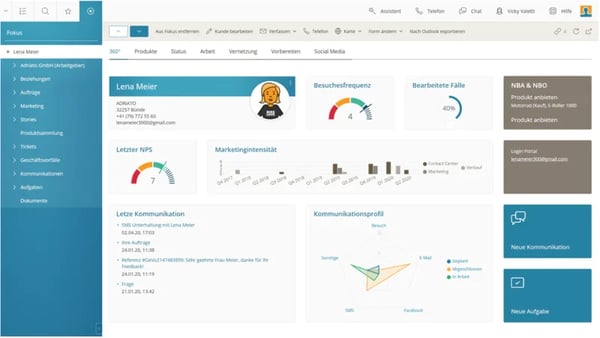
Source: bsi-software.com
If a company focuses more on marketing automation in conjunction with efficient sales, HubSpot's exceptionally user-friendly and intuitive Marketing & Sales platform is an optimal choice.

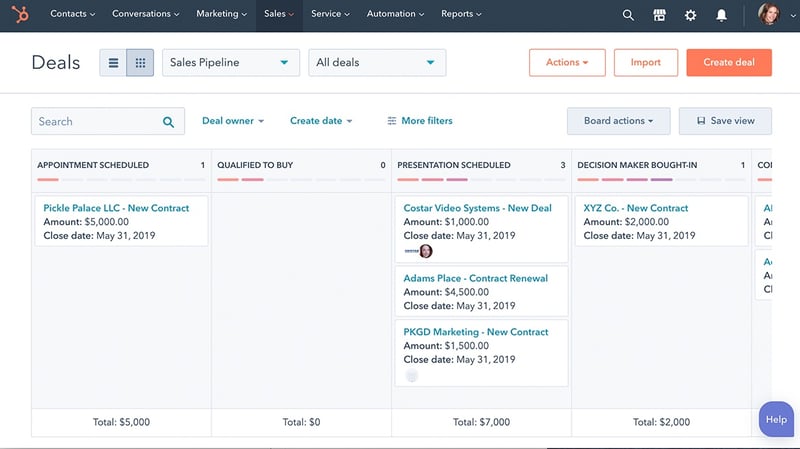 Source: HubSpot
Source: HubSpot
2. INDIVIDUALISED CUSTOMER APPROACH
Mass media are omnipresent in our everyday lives. As the name suggests, they usually address a broad mass. The consumer is one of many and is often treated or addressed as such. With an individualised approach to potential customers, interested parties feel perceived and valued as individuals. This creates a feeling of exclusivity, which increases the chances of a response.
Comprehensive and targeted data collection and analysis are the basis of an individualised approach and personalised content creation. Companies can thus get to know their (potential) customers on a more personal level and respond better to their needs. This strengthens customer loyalty and encourages repeat business and word of mouth.
3. CONTINUED EDUCATION AND TRAINING
Sales staff are a particularly important point of contact for (potential) customers for questions and generally as support for making a purchase decision. Therefore, it can also be an optimisation to adequately train and educate the sales team or individual employees to improve their skills and product knowledge. Only with the appropriate know-how can an excellent service be created. Further training can increase the motivation of employees. Well-trained sales teams can work more effectively, increasing the chances of success.
Especially in view of the rapid developments in the field of AI, further training is highly recommended. Those who implement smart, AI-supported tools and do not train their employees accordingly run the risk of not exploiting the full potential of such tools and giving away valuable advantages.
Very often, the software manufacturers or external service providers offer training on the software (either in person or in the form of online courses). For example, the HubSpot Academy is a great platform to get to know the various HubSpot "hubs" (tools) and gain further useful information and knowledge about marketing and sales. Another recommended example: the US e-learning platform Udemy. With 50 million participants, it is the largest online learning platform in the world and offers many different online courses on IT & software, business, marketing, sales and much more.
Advantages of optimally trained employees:
- reduced error rate
- Motivation & commitment increase
- Customer satisfaction increases
- possible competitive advantage
- promotes creative ideas & innovative approaches
- improved adaptation to changing customer needs
- Effectiveness and efficiency increase
- and much more.
4. Post-Sale Engagement
After the purchase is before the purchase! If you want to have satisfied customers and retain them in the long term, you can't do without post-sale engagement management.
An appealing post-sale engagement ensures that customers feel valued. This increases satisfaction and loyalty to the company and can lead to long-term business relationships.
According to the HubSpot study "Sales Strategy & Trends Report 2023", building a customer relationship ranks number 1 among the top 3 B2B sales strategies: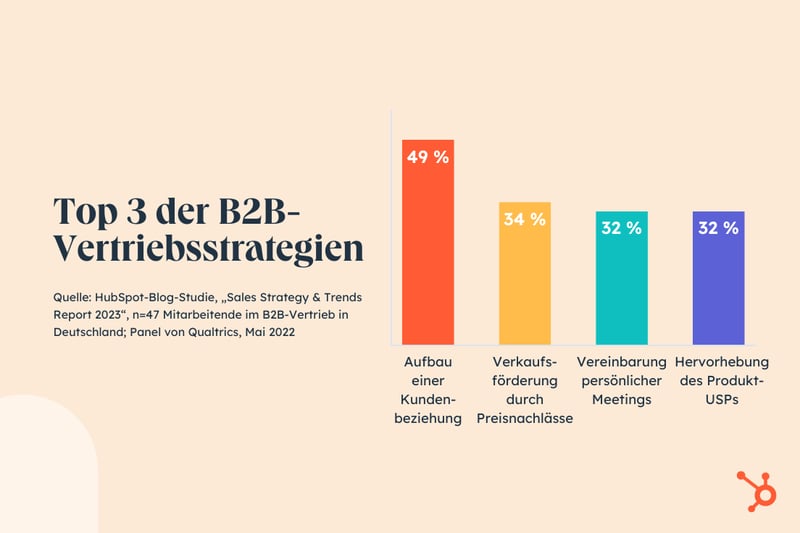
For existing customer relationships, cross-selling and up-selling are promising strategies to encourage repeat purchases. This involves offering additional products and services. This is often easier than convincing a new customer of offers. Post-sale engagement offers the opportunity to better understand customer needs and offer targeted, tailored solutions.
Effective post-sales engagement usually includes gathering customer feedback. This shows the customer that their opinion is valued and provides valuable information that can be used to optimise processes, products and services.
Furthermore, "social proof" is a real secret weapon in marketing & sales. For example, offer your customers the opportunity to leave a review or encourage them to share feedback via social media. A good post-sale engagement can lead to positive "word of mouth" or social proof and thus strengthen the reputation of the company.
In addition, an adequate post-sales engagement process ensures that potential problems and conflicts that may arise after a purchase can be identified and resolved more quickly. The goal here is to counteract a possible escalation, such as a loss of reputation due to bad comments or ratings, for example. A quick reaction to problems in combination with the incentive to want to fix them shows the customer your commitment as well as customer orientation and can minimise negative effects.
5. FEEDBACK LOOPS AND CONTINUOUS IMPROVEMENT
Gathering customer feedback is an important basis for continuous improvement of products and services. Companies that strive to better understand the needs and expectations of their customers can make targeted adjustments in marketing & sales and have a better chance of success. It is important to remember that the needs and expectations of (potential) customers can always change. Feedback measures are therefore not a one-off action, but should be carried out regularly or even continuously for a continuous improvement of the company processes.
Customer feedback helps to identify weaknesses and problems in the sales processes. Moreover, customers feel heard and valued when they are asked for their opinion. This aspect is conducive to building long-term customer relationships.
Furthermore, customer feedback is an excellent source of inspiration for product developments. It can provide valuable suggestions for optimisations or (further) developments of products and services.
There are a variety of ways to collect feedback. Below is a small compilation of the most common forms:
- Surveys (online or offline): short surveys after a customer experience or more in-depth market research surveys to ask for opinions and needs.
- Customer ratings and reviews: classic star rating, provide a platform for reviews or use external review platforms such as Yelp or TripAdvisor
- Feedback forms: which can be integrated on the website, for example
- Customer hotline and support chat with feedback option
- Social media platforms: to collect comments and ratings
- Asking for feedback via email
- Focus groups: Invite customers to participate in group discussions to discuss specific issues and provide feedback
- Provide online forums and community platforms for lively exchanges
- and much more.
6. PREDICTIVE ANALYTICS AND SALES FORECASTING
Predictive analytics can be used in many areas to make predictions about specific events or user behaviours. They can be promisingly used to evaluate and prioritise (potential) customers or leads in the context of lead scoring.
Sales forecasts are also much more accurate thanks to predictive analytics. By analysing historical sales data, seasonal trends and other factors, companies can make sound predictions about future sales results. This enables optimal budget and resource planning in sales.
In addition, customer retention rates benefit significantly from predictive analytics. By analysing customer behaviour data, companies can identify early on when customers are showing signs of churn. Sales teams can act quickly and prevent churn through preventive marketing actions such as loyalty programmes or feedback offers.
Predictive analytics also enable personalised product recommendations for customers, increasing cross-selling and upselling opportunities.
Furthermore, they can analyse the entire sales process and identify optimisation potential. From pricing to sales tactics and channels to distribution of sales resources, predictions and suggestions for improvement can be offered. Companies that rely on large inventories can optimise their inventory and warehouse management thanks to predictive analytics. Predicting demand and sales cycles can minimise overstocks and understocks in the warehouse.
For example, Motor Oil Group achieves more than 77 per cent accuracy in inferring unusual events between 120 and 20 hours in advance, based on root cause analysis of historical data, thanks to predictive analytics.
Sales force management can also benefit from predictive analytics, for example by offering suggestions on how to efficiently allocate sales staff to customers and territories. This can lead to reduced travel costs and increased customer satisfaction. The focus here is to deploy the right resources in the right place. The entire customer lifecycle could also be managed via predictive analytics - from lead generation to sales to retention and encouraging repeat purchases.
In summary, predictive analytics can significantly optimise – if not revolutionise – the sales process. They enable the sales team to focus on the really important things such as promising customers and process optimisations.
7. CROSS-SELLING AND UP-SELLING WITH DATA ANALYSIS
Cross-Selling
Cross-selling refers to the marketing strategy of offering customers additional products or services that are complementary or related to what has already been purchased by the customer. The aim is to encourage the customer to make additional purchases and increase the average order value. The classic example of this is offering accessories to the customer. More and more often, one also sees the section "Customers who bought this product also bought ..." in online shops.
Up-Selling
The up-selling strategy aims to convince customers to buy a more expensive or more extensive product or service than originally planned or selected. The goal here is to increase the value of a single sale.
According to HubSpot's survey of more than 500 salespeople, 72% of up-sellers and 74% of cross-sellers say it accounts for up to 30% of their sales.
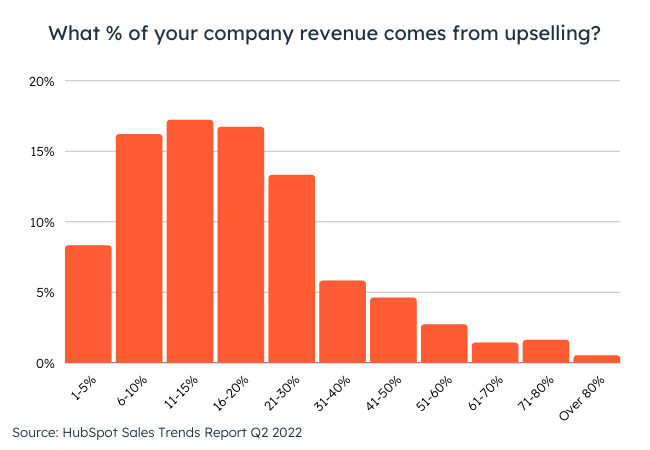
In both strategies, comprehensive data analysis can enable a much more efficient sales process. Through analysis, really promising "candidates" for cross-selling and up-selling can be identified. The basis for these sales strategies are usually segmentations of customers. For example, customers who have bought a car could receive a newsletter on the latest accessories for their car brand, or customers who have a certain mobile phone contract could receive an offer for an upgrade with more data volume at a promotional price. In both cases, segmentation could be based on the purchase already made.
CONCLUSION
As the previous explanations have shown, there are many starting points for possible optimisations along the sales process. Which measures or optimisations are important, relevant or should be prioritised for the respective company depends on many factors such as the setup of the sales process, the company characteristics, the industry and the sales goals. What is certain, however, is that there is usually always something to optimise, as the entrepreneurial and economic circumstances as well as customer needs and expectations are always changing. Progressive digitalisation and technological developments make stagnation virtually unacceptable if you want to ensure the success of your company.
Intelligent tools can significantly improve the sales process, make it more efficient and optimise its quality in order to meet the expectations of (potential) customers. An individualised customer approach, personalised content, further education and training for sales staff, feedback options for customers, predictive analytics and appealing sales strategies such as data-supported up- and cross-selling are optimisation factors that a forward-looking company should definitely consider in order to increase the company's success.
Would you like to learn more about smart sales strategies or intelligent tools that can increase the success of your sales? Then feel free to contact the sales and software experts at W4! We will be happy to support you in word and deed with the implementation or optimisation of your sales process.






.webp)



